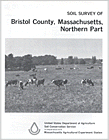Soil Survey of Bristol County, Massachusetts
NORTHERN PART

The following Map Unit Description is from the 1981 Soil Survey of Bristol County, NORTHERN Part. Please note: map unit symbols are DIFFERENT for Bristol North and Bristol South reports, do NOT use these descriptions for Bristol South.
Ra-Raynham silt loam. This soil is deep, nearly level, and poorly drained. It is in low areas and depressions near large streams. Slopes are smooth and concave. The mapped areas are irregular in shape and range from 5 to 50 acres in size.
Typically, the surface layer is friable, dark grayish brown silt loam about 4 inches thick. The subsoil is friable silt loam and is 19 inches thick. It is yellowish brown and has dark yellowish brown and light olive gray mottles in the upper 9 inches and is grayish brown and has yellowish brown and brownish yellow mottles in the lower 10 inches. The substratum to a depth of 60 inches is friable, light brownish gray silt loam that has reddish brown and dark reddish brown mottles.
Included with this soil in mapping are areas of Scio, Birdsall, Walpole Variant, and Amostown soils that are generally less than 4 acres in size. Included soils make up about 20 to 30 percent of the map unit.
Permeability is moderately slow or moderate in the subsoil and slow in the substratum. Available water capacity is high. Reaction is very strongly acid or strongly acid in the subsoil, and strongly acid in the sub- stratum. The root zone extends to the substratum, but root growth is impeded by the seasonal high water table. The water table is at or near the surface 6 to 8 months of the year.
This soil has fair potential for farming. It has poor potential for urban use and for most sanitary waste disposal facilities. This soil has fair to poor potential for trees, and fair potential for wetland wildlife habitat. Most acreage is in woodland.
The soil is poorly suited to cultivated crops. It is better suited to hay and improved pasture. Wetness is the main limitation. The hazard of erosion is slight. Conservation management includes installing field drainage systems if outlets are available, improving soil tilth, and maintaining organic-matter content. If this soil is cultivated, the use of minimum tillage, cover crops, and grasses and legumes in the cropping system help improve tilth and increase organic-matter content. Proper stocking rates, deferred grazing, and pasture rotation are management practices that help to maintain desirable pasture plants.
The soil is limited for most management practices used .in the growing and harvesting of trees because of the
seasonal high water table. Productivity is moderate. Important tree species are eastern white pine and red maple.
The soil has limitations for most urban use and for sanitary waste disposal facilities. The high water table and slow permeability are limitations. Capability subclass IIIw.